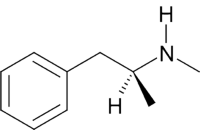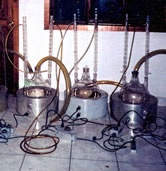Six years ago, David Geres, a high school sophomore from Vernon, Conn., accidentally took a double dose of a drug he'd been prescribed to control hyperactivity. The extra pill gave him a shot of energy and a huge boost in self-confidence. "I felt like Superman," Geres, now 22, recalls. "It was the best thing that had ever happened to me." So he kept taking double his prescribed dose.
The prescription drug Geres was taking is an amphetamine, a chemical that speeds up activity in the brain and other nerves. When Geres ran out of it, he learned how to cook methamphetamine, an even more potent form of amphetamine, also known as "meth," "chalk" and "speed."
Soon nothing but meth mattered to Geres--not school, not his budding career as a music recording engineer. "I got to the point where I was taking as much as I possibly could without dying," Geres told Current Science. "I needed the drug to function. Without it, I couldn't wake up in the morning and face anything."
At 19, Geres finally quit his habit. But By then he had flunked out of school, largely given up on his music, and lost three years of his life.
Geres is just one of many young people whose lives meth has shattered. Some 1.3 million Americans used the drug in 2003, according to the National Survey on Drug Use and Health, and 174,000 of those were 12- to 17-year-olds.
WIRED
Developed in the early 1900s, methamphetamine used to be an ingredient in over-the-counter nasal decongestants. Today, doctors prescribe it only rarely--in some cases to treat attention deficit/hyperactivity disorder (ADHD). Most meth is made illegally, in the form of a white powder that dissolves in water. Another form, crystal meth, comes in clear chunky crystals. People who take the drug snort, smoke, inject; or swallow it to experience a high (a feeling of euphoria).
Like many other illegal drugs, meth creates a high by producing a surge in the chemical dopamine in the brain. Dopamine is a neurotransmitter, a substance that brain cells use to communicate with one another. Dopamine also stimulates the brain's reward centers, inducing feelings of pleasure. A meth high can last all day, says Jerry Frankenheim, of the National Institute on Drug Abuse. By contrast, the high delivered by crack cocaine is gone in about a half hour.
Methamphetamine use has many telltale signs. It makes users unusually alert, talkative, and physically active. It also suppresses thirst, appetite, and the need to sleep. When Geres was on the drug, he could stay awake for days to a week, eating almost nothing. He lost weight yet still had enough energy to exercise. He believed that meth made him smarter and more likable. "You think everything's going great," he says, "even things you don't like to do."
HOOKED
Geres's life quickly came to revolve around meth. He was addicted. Even though he knew it was harming him, he couldn't stop using the drug. "It puts you in a state of mind that's unnatural, so that when you are not taking it, you always want it," he says.
Methamphetamine is one of the most addictive of all drugs, experts say. "The lives of users boil down to a single desire: more methamphetamine," says Charles Curie, head of the Substance Abuse and Mental Health Services Administration (SAMHSA).
Geres lost interest in school and failed his courses. He was arrested for pushing the drug. After long meth binges, he would crash, sleeping much of the time and becoming so depressed, he lacked the will to do much of anything--until he was back on the drug.
TOXIC EFFECTS
Rashelle Chaplin, a former user who lives outside St. Louis, also got hooked on meth. "I was inside my own mind, saying 'I need to get out of this place,'" she says. Chaplin's ex-husband was a user too. He once ran after her with a butcher knife while he was on meth.
Violent outbursts are just one of many toxic effects that meth has on body and mind. Some addicts constantly grind their teeth or fail to brush them, causing their teeth to rot. Others pick obsessively at their hair or skin, sometimes for hours on end, leaving themselves bald or covered in scabs. Addicts can become so emaciated that they look like skeletons.
Meth can constrict (narrow) blood vessels, causing so little blood to flow to the heart that some of its muscle tissue dies in other words, a heart attack. The drug can also lead to a hemorrhagic stroke, a burst blood vessel in the brain. High doses can boost the body's temperature to life-threatening levels or induce convulsions, uncontrollable muscle spasms.
Such dangers often land meth abusers in hospital emergency rooms (ERs). Methamphetamine-related ER visits rose about 70 percent between 1999 and 2002, according to the Drug Abuse Warning Network.
PERMANENT INJURIES
In experiments on animals, methamphetamine has been found to injure dopamine-producing cells, hampering the brain's ability to produce enough of the neurotransmitter on its own. That injury, researchers speculate, may be what leads to certain mental problems that persist after the drug is long gone.
Some former users, such as Chaplin, experience bouts of depression a disorder in which people feel down or hopeless for long periods of time. "I have to be on depression medication forever because I messed up my brain," Chaplin says. "It haunts you for the rest of your life."
Addicts also run a high risk of psychosis--they lose touch with reality. Some hear imaginary voices. Many become paranoid, believing that other people are out to hurt them. "In extreme cases," Frankenheim says, "people lock themselves in a room and feel that [the bad] people are going to come through the walls anyway."
KICKING THE HABIT
Believe it or not, Geres and Chaplin are lucky. They're still alive. Methamphetamine can kill, and every year many people die from the drug's effects or from accidents such as deadly explosions in labs where the drug is fabricated.
Although the use of some illegal drugs has declined in recent years, methamphetamine has held steady in popularity, Curie of the SAMHSA told Current Science. Its use is also spreading from hot spots in the western United States to points east. "It is coming into new areas," Curie says.
The good news is that treatment programs are available around the country. Admission to meth programs rose about 10 percent between 2002 and 2003. More than 17 percent of people in treatment started using the drug by age 14, according to SAMHSA.
After using meth for eight years, Chaplin managed to quit on her own. Geres eventually had a crash so severe, he lost the motivation to make the drug. He slept for a month, came out of the haze, and said to himself, "No way am I going back to that."
Geres is finally close to graduating from high school. He lives at home and works in a recording studio. Thoughts of meth still plague him. "I crave it all the time," he says. "But then I think about the past and how I was and say, 'Yeah, right.' God ... it was terrible."
Side Effects
Methamphetamine attacks mind and body.
* Depression, paranoia, psychosis, memory loss
* "Meth bugs" (infected sores) on skin, which are slow to heal
* Extreme loss of appetite
* Malnutrition
* Anorexia
* Breakdown of muscle tissue, which can lead to kidney failure
* Bone loss from mineral and vitamin deficiencies
* Loss of vision
* Tooth decay
* Drying of salivary glands
* Permanent nerve damage
* Respiratory failure
* Burned esophagus and lungs caused by toxic vapors
* Formation of crystals in the lungs
* Chest pain
* High blood pressure
* Buildup of fluid in the lungs and brain
* Internal bleeding and ruptured blood vessels
Critical Thinking
* If you discovered that a friend of yours was using methamphetamine, how would you convince him or her to stop?
* What might motivate teens to experiment with dangerous substances that they have been warned against using?
National Science Education Standards
* Personal and community health: substance abuse
Internet Links
* Newsweek:America's Most Dangerous Drug: www.msnbc.msn.com/id/8770112/site/newsweek
* Wikipedia: Methamphetamine:en.wikipedia.org/wiki/Methamphetamine
* Drug Policy Information
Clearinghouse: Methamphetamine:www.whitehousedrugpolicy.gov/publications/factsht/methamph
Answer:
1. An amphetamine is a chemical that speeds up activity in the brain and other nerves.
2. Meth can constrict blood vessels that feed the heart, causing some of the heart muscle to die.
3. Amphetamines can be used to treat hyperactivity.
4. Meth produces a surge in dopamine, a neurotransmitter that stimulates the brain's reward centers and produces feelings of pleasure.
5. People who use meth may suffer from depression, psychosis, paranoia, and memory loss.
COPYRIGHT 2005 Weekly Reader Corp.
COPYRIGHT 2005 Gale Group



